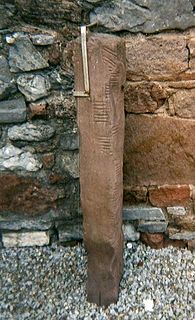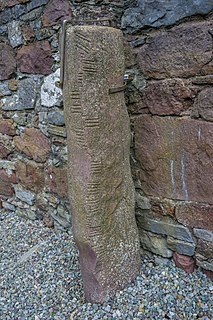
Ogham is an Early Medieval alphabet used primarily to write the early Irish language, and later the Old Irish language. There are roughly 400 surviving orthodox inscriptions on stone monuments throughout Ireland and western Britain; the bulk of which are in southern Munster. The largest number outside Ireland are in Pembrokeshire, Wales.

Primitive Irish or Archaic Irish is the oldest known form of the Goidelic languages. It is known only from fragments, mostly personal names, inscribed on stone in the ogham alphabet in Ireland and western Great Britain from around the 4th to the 7th or 8th centuries.
Beith (ᚁ) is the Irish name of the first letter of the Ogham alphabet, meaning "birch". In Old Irish, the letter name was Beithe, which is related to Welsh bedw(en), Breton bezv(enn), and Latin betula. Its Proto-Indo-European root was *gʷet- 'resin, gum'. Its phonetic value is.
Luis (ᚂ) is the second letter of the Ogham alphabet, derived either from luise "flame" or from lus "herb". Its Proto-Indo-European root was either *leuk- 'to shine' or *leudh- 'to grow'. Its phonetic value is [l]. If the letter name follows the same pattern as ruise to ruis, it is likely that the letter was originally named from luise, though different kennings point to both meanings.
Ceirt (Queirt) ᚊ is a letter of the Ogham alphabet, transcribed as Q. It expresses the Primitive Irish labiovelar phoneme. The 14th century Auraicept na n-Éces glosses the name as aball, meaning "apple tree". Its phonetic value is.
The Forfeda are the "additional" letters of the Ogham alphabet, beyond the basic inventory of twenty signs. Their name derives from fid and the prefix for- ("additional"). The most important of these are five forfeda which were arranged in their own aicme or class, and were invented in the Old Irish period, several centuries after the peak of Ogham usage. They appear to have represented sounds felt to be missing from the original alphabet, maybe é(o), ó(i), ú(i), p and ch.
In Early Irish literature a Bríatharogam is a two word kenning which explains the meanings of the names of the letters of the Ogham alphabet. Three variant lists of bríatharogaim or 'word-oghams' have been preserved, dating to the Old Irish period. They are as follows:
Nion (ᚅ) is the Irish name of the fifth letter of the Ogham alphabet, with phonetic value [n]. The Old Irish letter name, Nin, may derive from Old Irish homonyms nin/ninach meaning "fork/forked" and "loft/lofty". Nin is notable for being the old name that refers both to this specific letter, and to any of the Ogham letters in general.
Fearn (ᚃ) is the Irish name of the third letter of the Ogham alphabet, meaning "alder-tree". In Old Irish, the letter name was fern[fʲer͈n͈], which is related to Welsh gwern(en), meaning "alder-tree(s)". Its Primitive Irish root was *wernā and its phonetic value then was [w]. Its Old Irish and modern phonetic value is [f].
Sail or Saille (ᚄ) is the Irish name of the fourth letter of the Ogham alphabet, meaning "willow". The name is related to Welsh helyg(en) and Latin salix. Its Proto-Indo-European root was *sal- meaning "dirty,grey". Its phonetic value is [s].
Dair is the Irish name of the seventh letter of the Ogham alphabet, ᚇ, meaning "oak". The Old Irish: dair is related to Welsh derw(en) and to Breton derv(enn). Its Proto-Indo-European root was *dóru ("tree"), possibly a deadjectival noun of *deru-, *drew-. Its phonetic value is [d].
Coll is the Irish name of the ninth letter of the Ogham alphabet ᚉ, meaning "hazel-tree", which is related to Welsh collen pl. cyll, and Latin corulus. Its Proto-Indo-European root was *kos(e)lo-. Its phonetic value is [k].
Ruis (ᚏ) is the fifteenth letter of the Ogham alphabet, derived from ruise "red" or "reddening". The kennings refer to the reddening of the face caused by intense emotion, and medieval glossators also refer to the practice of reddening the cheeks with the juice of plants. Its Proto-Indo-European root was *h₁reudʰ- 'red'. Its phonetic value is [r].
Tinne is the Irish name of the eighth letter of the Ogham alphabet, ᚈ, meaning "ingot" or "iron bar". Its phonetic value is [t].
Muin is the Irish name of the eleventh letter of the Ogham alphabet, ᚋ. The bríatharogaim kennings reflect the fact the Old Irish muin has three homonyms meaning "neck, upper part of the back", "wile, ruse, trick", and "love, esteem". Which of these gave the letter its name is not know for certain, but is thought to be "neck". This is related to the archaic Welsh mwn ("neck") and Latin monile. Its phonetic value is [m].
Gort is the Irish name of the twelfth letter of the Ogham alphabet, ᚌ, meaning "field", which is related to Welsh garth 'garden' and Latin hortus. Its Proto-Indo-European root was *gher-, *ghort- 'to enclose, enclosure'. Its phonetic value is [ɡ].
Úr is the Irish name of the eighteenth letter of the Ogham alphabet, ᚒ, meaning "clay", "earth", "soil" and also "fresh" or "moist". In Old Irish, the letter name was also written Úir. Its phonetic value is [u] or [u:].
Ailm is the Irish name of the sixteenth letter of the Ogham alphabet, ᚐ. Its phonetic value is [a]. The original meaning of the name cannot be established with certainty. The Bríatharogam kennings all refer to the sound [a] and not to the meaning of the letter name, either as the sound of a "groan", or to the Irish vocative particle, á. Thurneysen suggests that Ailm, Beithe was influenced by Alpha, Beta. However, beithe is an Irish word, and there is no reason to consider ailm a sole, loaned letter name among the original feda; Thurneysen did not suggest this letter name involved such a borrowing. The word is attested once outside of the Ogham grammatical texts, in the poem "King Henry and the Hermit",
Eadhadh is the Irish name of the nineteenth letter of the Ogham alphabet, ᚓ. In Old Irish, the letter name was Edad. Its phonetic value is [e]. The original meaning of the letter name is unknown, but it is likely an artificially altered pairing with Idad, much like Gothic pairþra, qairþra.
Iodhadh is the Irish name of the twentieth letter of the Ogham alphabet, ᚔ. In Old Irish, the letter name was idad. Its phonetic value is [i]. The original meaning of the letter name is uncertain, but it is likely an artificially altered pair with edad, much like Gothic pairþra, qairþra, and may refer to "yew".

